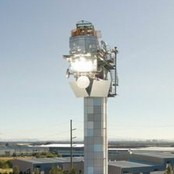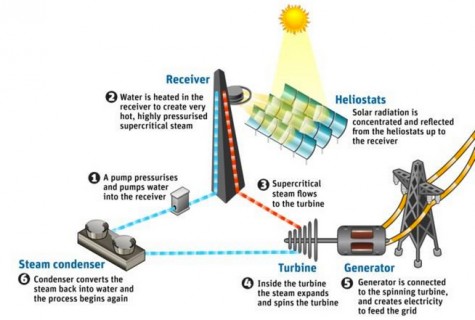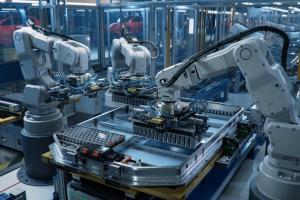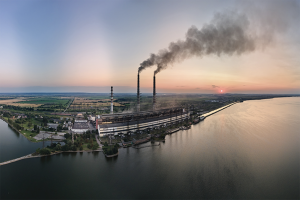After recently completing the 100 MW Shams 1 in Abu Dhabi and the 280 MW Solana plant in the desert near Gila Bend, Arizona, Abengoa Solar is busy building concentrated solar power (CSP) plants all over the world. The company's been on a roll and now says that its solar tower technology, when coupled with storage, will be competitive with gas-powered generation by 2020.
To prove that point, Abengoa's research partners at Australia's Commonwealth Science and Industrial Research Organization (CSIRO) in Newcastle, Australia, generated "supercritical" steam at a test plant, using more than 600 heliostats directed at a receiver tower (see press release).
 The term "supercritical," which is as close as any researcher will ever come to sounding like a Valley girl, refers to an ultra-hot, ultra-pressurized steam that drives the world's most advanced power plant turbines, which are still the exclusive domain of coal and gas. With the high pressure of supercritical steam power plants, as the boiling temperature increases, the latent heat of vaporization decreases to zero; in other words, water is converted directly to steam. Supercritical steam increases efficiency, typically 3.5 percent more than subcritical fossil fuel plants.
The term "supercritical," which is as close as any researcher will ever come to sounding like a Valley girl, refers to an ultra-hot, ultra-pressurized steam that drives the world's most advanced power plant turbines, which are still the exclusive domain of coal and gas. With the high pressure of supercritical steam power plants, as the boiling temperature increases, the latent heat of vaporization decreases to zero; in other words, water is converted directly to steam. Supercritical steam increases efficiency, typically 3.5 percent more than subcritical fossil fuel plants.
A true game changer
Current CSP plants operate in the subcritical realm at lower pressures. The world record, set in May, was at a pressure of 3,400 psi and temperatures up to 1,058? F. It is the combination of pressure and temperature demonstrated at scale that makes this such a breakthrough for solar power. As an honorary member of the Supercritical Carbon Club (bragging rights included), CSP's breakthrough means that someday solar energy will take these specialized turbines out for a spin. CSIRO's Energy Director, Dr. Alex Wonhas said this is a game-changer for the renewable energy industry. "It's like breaking the sound barrier; this step change proves solar has the potential to compete with the peak performance capabilities of fossil fuel sources." Ironically, while about 90 percent of Australia's electricity is generated using fossil fuel, only a small number use supercritical steam. So this isn't a big game of catch up. In the not so distant future, utilities could chose between upgrading coal or going with CSP. "This breakthrough demonstrates that the power plants of the future could be using the free, zero emission energy of the sun to achieve the same result," Dr Wonhas said. Another important aspect of an Abengoa plant is its closed-loop design, which saves a lot of water: Developing nations could choose CSP
As the number of CSP power plants increase, a new study shows how in some regions a network of concentrating solar power plants could provide the same grid reliability as conventional power plants, without any extra cost. It also showed that some developing countries, simply by leap-frogging natural gas with CSP, could modernize their grid electricity supply.
The study, "Potential for Concentrating Solar Power to Provide Baseload and Dispatchable Power," was just published in the journal Nature Climate Change. The key finding is that CSP planning needs to be done on a national or regional level to create a coordinated network, rather than leaving a series of standalone projects.
They tested this by simulating the operation of CSP networks using thermal storage in four world regions where CSP is already deployed. They optimized siting and operation within realistic scenarios, and showed that with a well designed system, it's possible to get up to half of peak capacity before CSP plant costs substantially increase.
Furthermore, the study singled out one key geographical area:
Developing nations could choose CSP
As the number of CSP power plants increase, a new study shows how in some regions a network of concentrating solar power plants could provide the same grid reliability as conventional power plants, without any extra cost. It also showed that some developing countries, simply by leap-frogging natural gas with CSP, could modernize their grid electricity supply.
The study, "Potential for Concentrating Solar Power to Provide Baseload and Dispatchable Power," was just published in the journal Nature Climate Change. The key finding is that CSP planning needs to be done on a national or regional level to create a coordinated network, rather than leaving a series of standalone projects.
They tested this by simulating the operation of CSP networks using thermal storage in four world regions where CSP is already deployed. They optimized siting and operation within realistic scenarios, and showed that with a well designed system, it's possible to get up to half of peak capacity before CSP plant costs substantially increase.
Furthermore, the study singled out one key geographical area:
In the Mediterranean region, the study shows that a connected CSP system could provide 70-80% of current electricity demand, at no extra cost compared to gas-fired power plants. That percentage is similar to what a standard energy production plant, such as a nuclear plant, can provide.





